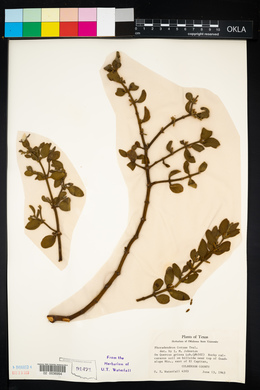Phoradendron leucarpum subsp. tomentosum
|
Phoradendron leucarpum subsp. tomentosum (DC.) J.R. Abbott & R.L. Thompson
 (redirected from: Phoradendron havardianum Trel.) (redirected from: Phoradendron havardianum Trel.) |
|
|
Family: Santalaceae
mistletoe, more...Cory's mistletoe (es: toji (generic), injerto, liga, seca palo, silmo)
[Phoradendron coryae Trel., morePhoradendron flavescens var. pubescens Engelm. ex A.Gray, Phoradendron greggii Trel., Phoradendron havardianum Trel., Phoradendron serotinum subsp. tomentosum (DC.) Kuijt, Phoradendron serotinum var. pubescens (Engelm. ex A.Gray) M.C.Johnst., Phoradendron serotinum var. rotundifolium (Trel.) M.C. Johnst., Phoradendron thyrsoideum Trel., Phoradendron tomentosum Oliver, Phoradendron tomentosum subsp. leucarpum Kuijt, Phoradendron tomentosum subsp. tomentosum , Phoradendron tomentosum tomentosum , Phoradendron tomentosum var. tomentosum (DC.) Engelm. ex A. Gray, Phoradendron villosum subsp. coryae (Trel.) Wiens, Phoradendron villosum var. rotundifolium , Phoradendron wilkinsonii Trel., Viscum villosum Nutt.] |
SHOOTS: up to 1 m high, mostly short pubescent, gray-green, the internodes 2-3 cm long. LEAVES: obovate-elliptic to circular, 1.5-3 cm long, 1.5-2.5 cm wide, densely pubescent. INFLORESCENCE: staminate spikes with 2-3 fertile segments, with 25-40 flowers in 3 rows per segment; pistillate spikes with 2-3 fertile segments, with 6-10 flowers per segment. FLOWERS: pubescent. FRUIT: white, short hairy around the persistent perianth segments, ca. 3 mm in diameter. HOSTS: Quercus, rarely Condalia, Berberis, Vaquelinia and Sideroxylon. NOTES: Sub-Mogollon oak woodlands: all AZ cos. except Apache, La Paz, and Yuma; 1200-2700 m (4000-8800 ft); Jul-Sep; NM, w TX; Chih., Coah., Son., Mex. REFERENCES: Hawksworth, Frank G. 1994. Viscaceae. J. Ariz. - Nev. Acad. Sci. Volume 27(2), 241-245. Hawksworth 1993, Kearney and Peebles 1969, Martin and Hutchins 1980 Duration: Perennial Nativity: Native Lifeform: Subshrub General: Aerial parasitic shrub usually found on Quercus, with shoots to 1 m, mostly short pubescent, gray-green, with internodes 2-3 cm long. Leaves: Obovate-elliptic to circular, 1.5-3 cm long, 1.5-2.5 cm wide, densely pubescent. Flowers: Inflorescence a staminate spike with 2-3 fertile segments, each with 25-40 flowers in 3 rows per segment; pistillate spikes have 2-3 fertile segments, each with 25-40 flowers in 3 rows per segment; flowers pubescent. Fruits: White, berrylike, short hairy around the persistent perianth segments, about 3 mm in diameter. Ecology: Found on Quercus, Condalia, Berberis, Vaquelinia, and Sideroxylon in oak woodlands below the Mogollon Rim from 4,000-9,000 ft (1219-2743 m); flowers July-September. Notes: Distinguished not only by its host plant but also by its wide pubescent leaves, usually more than 1 cm in width. The species name is possibly changing to P. serotinum subsp. tomentosum. Stay tuned. Ethnobotany: Unknown but other species in the genera have uses. Etymology: Phoradendron is from Greek phor, a thief and dendron, tree-hence tree thief because of its parasitism, while coryae is of uncertain orgin. Synonyms: Phoradendron villosum subsp. coryae Editor: SBuckley, 2010 Hawksworth and Wiens 1993, Jepson 2012 Duration: Perennial Nativity: Native Lifeform: Subshrub General: Aerial, parasitic shrub, perennials, stems and shoots gray-green, erect to spreading, shoots to 1 m or more high, surfaces short-pubescent, especially near the apices, internodes 15-59 mm long, stems jointed and brittle when dry. Leaves: Opposite, obovate to elliptic-round, to 3 cm long and 2 cm wide, gray-green with dull surfaces, glabrous to densely short-hairy, petioled or not. Flowers: Small and inconspicuous, mostly green and slightly pubescent, inflorescences staminate and pistillate; staminate spikes with 4-7 fertile segments, with 20-40 flowers per segment in 3 rows; pistillate spikes with 3-5 fertile segments, with 6-15 flowers per segment. Fruits: White to pink-tinged, globose berries with glabrous surfaces, 4-5 mm in diameter. Seeds solitary. Ecology: Parasitic, generally found on Quercus, rarely on Adenostoma, Arctostaphylos, Rhus, and Umbellularia, from 200-7,000 ft (61-2134 m); flowering July-September. Distribution: California, north to Oregon, south to Texas and Mexico. Notes: Many sources consider the current name for this species to be Phoradendron serotinum subsp. tomentosum as of August 2012. USDA Plants has this species occurring only in Texas, Okalhoma, and Louisiana, distribution data here taken from Jepson 2012. Look to the gray-green leaves with dull surfaces of the leaves to help identify this species. The whitish clusters of berries are also distinctive of this genus, along with the large leaves. Ethnobotany: Specific uses for this species are unknown, but other species in the genus have uses; plant growing on cottonwood used medicinally for unspecified purpose, decoction of leaves taken for menstrual cramps, stomach cramps, powdered berries mixed with water and used to bathe sore or infected eyes, also ground berries mixed with a small amount of ashes, boiled in a pot and eaten, and bed of heated branches used by women for menstrual cramps, leaves used to dye basket weeds permanently black, used in the War Dance liniment, and twigs hung over the doorway of a hogan for protection from lightning. Synonyms: Phoradendron flavescens var. pubescens, P. serotinum var. pubescens Editor: LCrumbacher2012 Etymology: Phoradendron comes from the Greek phor, "a thief," and dendron, "tree," hence "tree thief" because it draws nourishment from its host tree, and tomentosum means densely covered with matted wool or short hair, tomentose. |
























































































